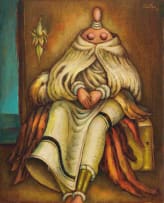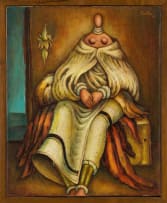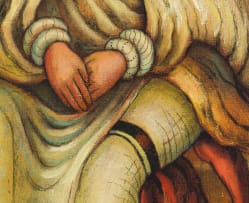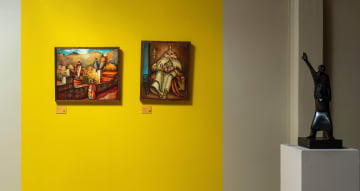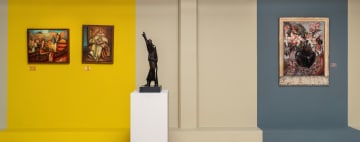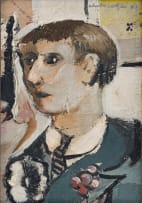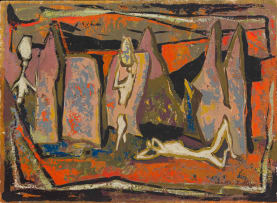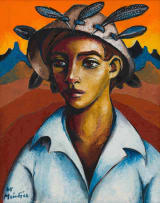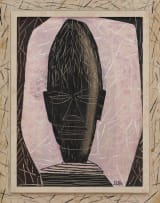Modern, Post-War and Contemporary Art
Live Virtual Auction, 17 - 18 May 2021
Modern, Post-War and Contemporary Art
Incl. Buyer's Premium & VAT
About this Item
signed and dated 51
Notes
In the December of 1935, having recently returned from a year at the Westminster School of Art in London, and shortly after closing his first ever exhibition at Glen's Music Salon in Pretoria, a twenty-four-year-old Alexis Preller, wide-eyed, motivated and curious, came across a group of women labourers on the northern outskirts of town, each of them turned out in dazzling traditional dress. Hammered and weighty brass rings glinted on their necks and ankles, and coloured beads decorated their aprons and armbands. These were Ndzundza-descended women of the Southern Ndebele people, and their village, to which a young Alexis followed them one day, with its stepped terraces, mud huts, enclosed kraals, and joyful, distinctive, painted walls, would become one of the artist's greatest sources of inspiration. His first painting to include these Ndebele figures, or Mapogga, as they were also called, was Native Study (Mapogges) [sic]; it showed them with long and gently cylindrical limbs and conical breasts, and it was one of the 117 paintings, and the only one by Alexis, exhibited at the Empire Exhibition at Milner Park in Johannesburg from September 1936.
In that same year, a young photographer called Constance Stuart, another ambitious artist who had grown up in Pretoria, became drawn to the mystique of the Mapogga too. Having outgrown her Kodak Box Brownie, trained in London between 1933 and 1935 at the Regent Street Polytechnic School of Photography, and thereafter at the Bavarian State Institute for Photography in Munich, Stuart turned her new Rolleiflex on the tribal cultures of southern Africa, and rather memorably, in her straightforward and black and white style, on the people of the Ndebele (figs. 1 and 2). She and Alexis plainly shared a passion, and they were firm friends by 1938 (Stuart purchased the only Mapogga picture on Preller's fourth solo show, held at the New Group Hall in Queen Street in Pretoria, in October 1938). Consequently, comparing their contemporaneous approaches to their Mapogga subject matter is particularly handy: Stuart's direct and documentary mode helps emphasize the visionary and daring way in which Preller interpreted the same theme. The Mapogga certainly became one of Preller's most iconic, spell-binding and protean motifs, and dominated many of his seminal paintings. Two such examples, both breathtaking and richly symbolic, are featured here. (Lots 191 and 192)
___
Preller's most bewitching early pictures were made in the pursuit of an essential and illusive African spirit. Thanks to his early brush with the Mapogga women, he became enchanted by the Swazi in 1937 (fig. 1), intrigued by figures in the Congo in 1939 (fig. 2), and inspired in 1947 by Constance Stuart's photo-essay of her travels in Basutoland. After his life-affirming trip to the Seychelles at the end of 1948, however, from which he produced a group of vivid and joyful tropical pictures, his imagination inevitably returned to the rituals, the architecture, the traditional dress, and the visual spell of the Mapogga. He sensed in this ancient culture a way to develop his own mythical concept of Africa. In 1949 this came to life in a painting called The Storm (fig. 3), a hazy and simplified vision of a Mapogga matriarch, monumental in scale, and beautifully enwrapped in a striped blanket; it was an evocative statement of things to come.
Throughout 1950 and 1951, Preller fixated on the Mapogga women. Dignified, perceptive and imposing, they seemed to embody an archaic and distinctly African spirit. Whether singly, with child, or in small groups, Preller revisited this figure endlessly, usually seated and in conical form, with legs outstretched, hands clasped, and blankets, beads and copper necklaces on show. While this Mapogga matriarch emerged as the artist's most dominant motif at the time, it undertook continuous symbolic and poetic transformations: Red Mother (fig. 4), for instance, seated against an earthen wall, nurtured a son, while Ritual Mapogga, her head mysteriously covered by a pink cloth, suggested some impenetrable, ceremonial custom. But the concept reached an initial apotheosis with Grand Mapogga I, as well as the gorgeous Grand Mapogga II, this sale's remarkable cover lot.
While no doubt related to the The Storm, the figure in Grand Mapogga II now appears closer to pure icon or symbol. Faceless, distant, still and enigmatic, its traditional blanket has changed to a glorious ivory-gold cloak. Surrounded by a gentle glow, moreover, the figure seems eternal, and far-removed from its everyday kraal. A maize cob appears on the wall behind, presumably an emblem of fertility, and a mark of this matriarch's power, role and influence.
The artist's fluid imagination took the Mapogga matriarch figure further still. After completing the vast and complex All Africa mural for the Receiver of Revenue building in Johannesburg, Preller returned to the theme in 1957 with three more epic versions (fig 5.).
Provenance
Die Kunskamer, Cape Town.
Private Collection, Johannesburg.
Exhibited
Gainsborough Gallery, Johannesburg, 12 to 25 February 1952, catalogue number 28.
Literature
Esmé Berman and Karel Nel (2009) Africa, the Sun and Shadows, volume I, Johannesburg: Shelf Publishing, illustrated in colour on page 149.

